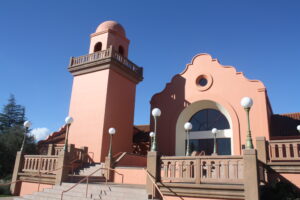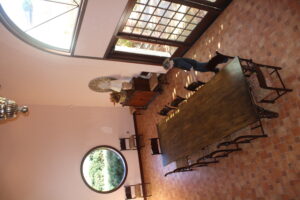There’s a certain mystique about visiting Groth (www.grothwines.com). When we tell knowledgeable friends that we’ve been there, we often get that look, as though we had joined them as members of a secret society of wine insiders. It’s hard to call Groth a cult wine but many of those who love their wines treat it that way.
So let’s deal with the wines first, before discussing the tasting experience there. They make Cabernet Sauvignon. Oh yes, they grow other Bordeaux blending grapes and they do have some white wines. But believe us (and the Groth people themselves) Groth is all about Cab. We don’t review wines at Power Tasting, but suffice it to say that their Cabernet Sauvignons are rather good and have won awards over the 40+ years they have been growing grapes and making wines.

The entrance to the Groth winery.
You don’t just drop in for a tasting at Groth. Their policy is strictly “by appointment only”. So, as you drive along the shady Oakville Cross Road and see Groth’s remarkable building, you will want to visit. To do so, however, you would have needed to make a reservation well in advance.
The building seems from afar like a pink stucco Spanish hacienda. It is set well off the road behind acres of vines, so that when you actually do approach you might find it surprising to see how large it is. That’s because it’s an industrial property where people crush grapes, age wine and then bottle and sell it. But it is also the home of the Groth family, so a visit to the winery is also a house call.
Inside the Groth winery.
That spirit is carried forward by the guide assigned to your visit who shows you round and serves you some wine. The hacienda feeling is enhanced by the furnishings, made of gleaming wood and seemingly antique. The daughter of the winery’s founder, now in charge of their operations, had once intended to be a professional artist and you can see several of her paintings on the walls.
Not surprisingly, the guides talk reverently about the Groths, particularly the founder, Dennis. We’ve also heard that tone applied to winery owners who inherited their wealth or bet early on Microsoft. When you walk around the winery, you might see old photos of Mr. Groth with fellows such as Mr. Mondavi, Mr. Winiarski and Mr. Heitz, you realize that he was one of Napa Valley’s pioneers. True, the Groth family came to the valley “only” in 1982. They intended to make fine Bordeaux style wines and they did it. It’s no mean feat to look back on your career and say that you accomplished your goal.
All that history means nothing to the visitor if the essentials aren’t there. But fine architecture, a warm greeting and good wine should always go together in Wine Country. Sadly, that’s not always the case in Napa Valley and elsewhere. Visitors should treasure the combination when they encounter it, as we have done at Groth.
